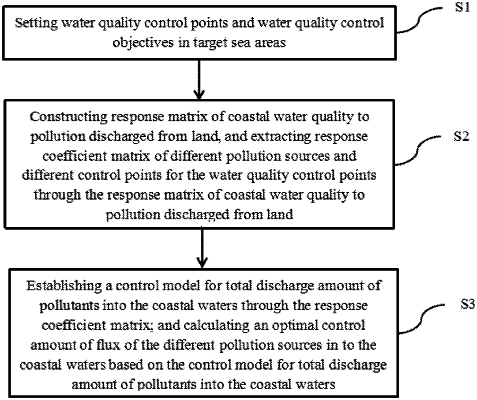| CPC G05B 19/416 (2013.01) [G05B 2219/37371 (2013.01)] | 4 Claims |

|
1. A method for optimal control of pollutant flux into waters based on virtual discharge amount, comprising:
setting water quality control points and water quality control objectives in target sea areas;
constructing response coefficient fields of coastal water quality to pollution sources discharged from the land, and extracting response coefficient matrix of the different pollution sources and different control points for the water quality control points through the response coefficient fields of coastal water quality to pollution sources discharged from the land; and
establishing a control model for a total discharge amount of pollutants into waters through the response coefficient matrix and calculating an optimal control amount of flux of the different pollution sources into the waters based on the control model for the total discharge amount of pollutants into the waters;
wherein constructing response coefficient fields of coastal water quality to pollution sources discharged from the land comprises:
calculating steady-state concentration fields formed by individual discharge of each pollution factor of each pollution source item under unit intensity respectively based on a relationship between response concentration of coastal water quality and pollution sources discharged from the land, and establishing a two-dimensional water quality model of the target sea areas based on pollution source positions and the water quality control points; simulating and studying effects of the different pollution sources discharged into the waters on the water quality of the sea areas based on the two-dimensional water quality model of the target sea areas, and obtaining the response coefficient fields of coastal water quality to pollution sources discharged from the land corresponding to the different pollution sources;
parameters of the response coefficient fields of coastal water quality to pollution sources discharged from the land comprise:
convective diffusion coefficients and boundary conditions, wherein the convective diffusion coefficients comprise a diffusion coefficient, an attenuation coefficient and an initial concentration, and the boundary conditions comprise open boundary conditions, inflow, outflow and shore boundary conditions;
establishing the control model for the total discharge amount of pollutants into the waters comprises:
a sum of actual pollutant concentrations at all water quality control points does not exceed a sum of target concentrations thereof, and a proportion of water quality exceeding a standard at each control point does not exceed a water quality regulation coefficient at that point, with a goal of maximizing the virtual total discharge amount in the sea areas, the total discharge amount control model of the pollutants is constructed by solving an optimal solution of an objective planning model;
an objective function of the control model for the total discharge amount of pollutants into the waters is:
 wherein Qj is a load of a j-th pollution source into the waters, λj(λj≥1) is a regulation coefficient of the j-th pollution source, Q is the virtual total discharge amount and n is a quantity of pollution sources discharged from the land into the waters; and constraints of the control model for the total discharge amount of pollutants into the waters comprise:
 wherein n is a quantity of pollution sources discharged from the land into the waters, m is a quantity of marine water quality control points, Ci0 is a background concentration of pollutants at an i-th water quality control point, CiS is a control target concentration of pollutants at i-th water quality control point, ri is a water quality regulation coefficient of the i-th water quality control point, and αij is a response coefficient of the unit discharge amount of the j-th pollution source to the pollutant concentration at the i-th water quality control point.
|